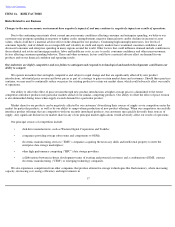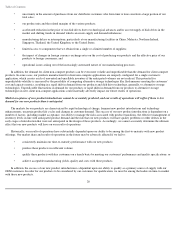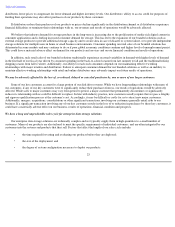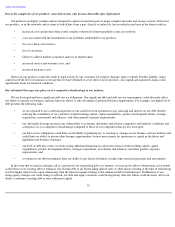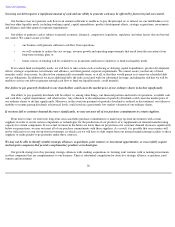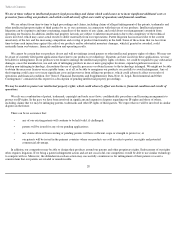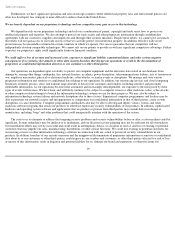Seagate 2013 Annual Report Download - page 25
Download and view the complete annual report
Please find page 25 of the 2013 Seagate annual report below. You can navigate through the pages in the report by either clicking on the pages listed below, or by using the keyword search tool below to find specific information within the annual report.
Table of Contents
If there is a shortage of, or delay in supplying us with, critical components, equipment or raw materials, then:
• it is likely that our suppliers would raise their prices and, if we could not pass these price increases to our customers, our
operating margin would decline;
• we might have to reengineer some products, which would likely cause production and shipment delays, make the reengineered
products more costly and provide us with a lower rate of return on these products;
• we would likely have to allocate the components we receive to certain of our products and ship less of others, which could reduce
our revenues and could cause us to lose sales to customers who could purchase more of their required products from
manufacturers that either did not experience these shortages or delays or that made different allocations; and
• we might be late in shipping products, causing potential customers to make purchases from our competitors, thus causing our
revenue and operating margin to decline.
We cannot assure you that we will be able to obtain critical components in a timely and economic manner.
We often aim to lead the market in new technology deployments and leverage unique and customized technology from single source
suppliers who are early adopters in the emerging market. Our options in supplier selection in these cases are limited and the supplier based
technology may consequently be single sourced until wider adoption of the technology occurs and any necessary licenses become available. In
such cases any technical issues in the supplier's technology may cause us to delay shipments of our new technology deployments and therefore
harm our financial position.
Changes in demand for computer systems and storage subsystems may in the future cause a decline in demand for our products.
Our products are components in computers, data storage systems, and consumer electronics devices. The demand for these products has
been volatile. Unexpected slowdowns in demand for computer systems, storage subsystems or consumer electronics devices generally cause
sharp declines in demand for our products. Declines in consumer spending could have a material adverse effect on demand for our products and
services and on our financial condition and results of operations.
Causes of declines in demand for our products in the past have included weakness in macroeconomic environments, announcements or
introductions of major new operating systems or semiconductor improvements or changes in consumer preferences, such as the shift to mobile
devices. We believe these announcements and introductions have from time to time caused consumers to defer their purchases and made
inventory obsolete. Whenever an oversupply of our products causes participants in our industry to have higher than anticipated inventory levels,
we experience even more intense price competition from other manufacturers than usual.
We are dependent on sales to distributors and retailers, which may increase price erosion and the volatility of our sales.
A substantial portion of our sales has been to distributors of disk drive products. Certain of our distributors may also market other products
that compete with our products. Product qualification programs in this distribution channel are limited, which increases the number of competing
products that are available to satisfy demand, particularly in times of lengthening product cycles. As a result, purchasing decisions in this
channel are based largely on price, terms and product availability. Sales volumes through this channel are also less predictable and subject to
greater volatility than sales to our OEM customers. In addition, deterioration in business and economic conditions could exacerbate price erosion
and volatility as
22







